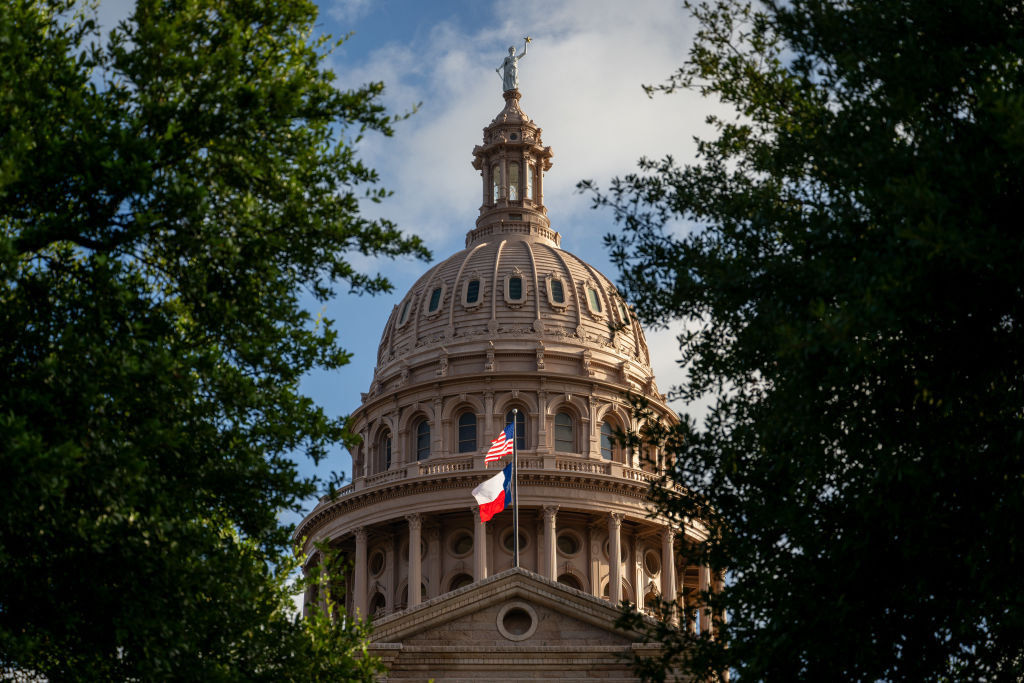PRESENTED BY

THE TOP
A Texas-sized gamble: Details on the new map

Happy Wednesday morning.
We have a lot of news for you on the new shape of the political universe in Texas.
As early as today, Texas Republicans will release their proposed new congressional map for the Lone Star State.
This proposal could change some as it winds its way through the Texas House and Senate. But here’s what we expect it to look like, according to multiple sources with detailed knowledge of the process.
Under this scenario, there would be five new seats that President Donald Trump would have carried by 10 or more points. This could give the GOP an advantage of 30 Republicans to eight Democrats in the Texas congressional delegation in the next Congress (it’s currently 25 Rs, 12 Dems and one vacancy).
It’s huge news in Austin and on Capitol Hill. It may help the GOP keep control of the House in 2026 — or trigger redistricting fights in other state capitals as Democrats retaliate.
As we’ve reported, three of these districts will be in or around Austin, Dallas and Houston. The other two will be in the Rio Grande Valley.
The targets. Here are the Democrats who are most directly in the danger zone.
1) Rep. Henry Cuellar in the Rio Grande Valley (currently the 28th District, although this may change). Thanks to South Texas’ rapid political realignment, Cuellar already represents a seat that Trump won by seven points. It may not get a whole lot worse than that but the longtime Democratic incumbent is also facing federal charges of bribery and money laundering.
2) Rep. Vicente Gonzalez in the Rio Grande Valley (34th District). Just like Cuellar’s district, this seat swung hard to the right in 2024 at the presidential level. Gonzalez survived a tough race in November but his seat is certainly getting redder.
3) Rep. Julie Johnson in the Dallas Metro area (32nd District). Republicans packed this district full of Democrats ahead of the 2022 cycle. Now, they want it back.
4) Reps. Greg Casar (35th District) and Lloyd Doggett (37th District). Casar’s district snakes up Interstate 35 between San Antonio and Austin. Doggett’s is Austin-based. Republicans are eyeing a new red seat in the region and that leaves just one district for Casar and Doggett.
This could be a fascinating primary. Casar, 36, and the youngest ever chair of the Congressional Progressive Caucus, versus Doggett, the 78-year-old dean of the Texas delegation. Doggett was the first House Democrat to call on President Joe Biden to exit the presidential race in 2024 following his disastrous debate with Trump.
5) Rep. Marc Veasey in the Dallas Metroplex (33rd District). Veasey’s district spans from Fort Worth to Dallas. It’s possible the new map will cut out the Fort Worth part of his district. That doesn’t mean Veasey won’t have a Dallas-based seat to run in, but he’s from Fort Worth. If Veasey retires, Johnson could run in that seat.
There will be a new GOP seat in the greater Houston metropolitan area. But remember: There is a vacant blue seat in Houston because Democratic Rep. Sylvester Turner died on March 5 and the special election to replace him isn’t until November.
That means it’s very possible that the area’s three current Democratic incumbents — Reps. Lizzie Fletcher, Al Green and Sylvia Garcia — will all have seats to run in, so we left them off our list of the most endangered.
The broader map. Democrats have declared that Republicans are at grave risk of spreading their voters too thin and creating districts that could flip blue in a bad year for Republicans. This kind of redraw is known as a “dummymander.”
Republicans feel their map avoids that outcome. They expect that every seat that Trump carried with at least 60% of the vote under the current Texas map will remain at that margin or better under the new map.
Trump won all the GOP-held seats or expected pickups by 10 points or more in 2024. GOP Reps. Beth Van Duyne and Troy Nehls will likely see the partisan voter indexes of their districts increase, while those of Reps. Tony Gonzales and Monica De La Cruz will stay roughly the same.
We’ve got a few details on how Republicans expect the five new red districts to look:
– One new seat will have a PVI of R+7. Trump won it by nearly 16 points.
– One new seat will have a PVI of R+3. Trump won it by 10 points.
– One new seat will have a PVI of R+8. Trump won it by nearly 18 points.
– Two new seats will have a PVI of R+4. Trump won them both by 10 points.
Sen. Ted Cruz (R-Texas) would have carried all five of these seats, while Gov. Greg Abbott would have won four of them.
One last thing: Republicans expect there will be more majority Hispanic districts in the new map proposal than there are in the current one. They’re making a big bet that the rightward shift of Latino voters seen in November is here to stay. Republicans also hope they are complicating the prospects of Democratic lawsuits.
ICYMI — We scooped in the PM edition that the White House is lobbying against a Senate bill to ban stock trading for members of Congress, the president and vice president. The Trump administration doesn’t agree with the ban on the president and VP.
– Ally Mutnick and Jake Sherman
Want to make sure your whole office has the full Punchbowl News experience? We have team plans available for companies, organizations, classes, Capitol Hill offices and more. Fill out this form and find out if your team is eligible for a discount.
PRESENTED BY THE BOEING COMPANY
As the largest manufacturing exporter in America, Boeing contributes $97 billion annually to the U.S. economy.
Global demand for Boeing aircraft supports 1.4 million American jobs across our supply chain. Approximately 80% of Boeing’s supply chain spending, along with 85% of our workforce, is based in the U.S.
THE SENATE
GDP, Fed meeting on tap as U.S. economy faces big day
Today is a monster day for U.S. economic politics.
At 8:30 a.m., the Bureau of Economic Analysis — part of the Commerce Department — will release the “advance” second quarter GDP estimate. The U.S. economy shrunk during the first quarter of 2025. But experts believe that the new data will show growth of between 1.7% to 2.4% in the second quarter, despite fears over inflation and trade wars.
And at 2 p.m., the Federal Open Market Committee will announce whether it intends to cut interest rates. Federal Reserve Chair Jay Powell will then hold a press conference at 2:30 p.m. to talk about his views on the state of the economy.
As you know by now — unless you’re literally living under a rock — President Donald Trump has a particular interest in the Fed cutting rates. Trump openly pressured Powell last week during his visit to the Fed’s headquarters, nominally a presidential check on the state of the Fed’s “lavish” renovation project and alleged massive cost overruns (it also spawned hundreds of great new memes!)
Trump basically told reporters that Powell’s problems would all disappear if he simply cut interest rates. “Well, I’d love him to lower interest rates,” Trump said when asked what it would take to back off “earlier criticism” of Powell. “Other than that, what can I tell you?”
Yet the president may not get what he wants, according to market watchers, who expect the Fed to leave rates unchanged for now but signal a possible cut in September. That means Washington, Wall Street and global financial markets are waiting to see what Trump does next.
Looking ahead. There’s little sense that Trump will actually try to fire Powell if the Fed doesn’t cut rates. Trump’s closest allies on Capitol Hill would be fine with it if he did, although there would be huge legal, political and economic fallout.
“My suspicion is he won’t make an interest-rate cut,” said Sen. Bernie Moreno (R-Ohio), who views Powell as a “complete partisan hack.”
“[Powell] has an ego the size of the universe,” Moreno added. “This guy has way too much power in his head.”
There’s also a number of Republicans who don’t want Trump to move against Powell, even though they don’t like the Fed chair either and would love to see him depart sooner rather than later.
“I think there’s a lot of downside to firing him,” said Sen. Roger Marshall (R-Kan.). “I’d rather [Powell] resign because we have no confidence in him. To me, the American people have no confidence in him.”
However, the majority of Republicans are still defending the Fed’s independence, even if that doesn’t line up with Trump’s views.
“Having an independent central bank is very important, and I hope that we continue to have an independent central bank,” Sen. Todd Young (R-Ind.) said.
Here’s Sen. John Kennedy (R-La.): “The Federal Open Market Committee should do what it thinks is right and forget the political pressure.”
Dems’ POV. Democrats are loudly demanding that Trump leave Powell alone. Even Sen. Elizabeth Warren (D-Mass.), a frequent critic who twice voted against Powell — his original nomination by Trump as Fed chair in 2017 and former President Joe Biden’s decision to tap him for a second term in 2021 — defends the Fed chair’s independence.
“I want to see interest rates go down, but there’s exactly one person who is responsible for keeping interest rates high and that’s Donald Trump,” Warren told us, pointing to the “chaos” of Trump’s numerous tariff moves.
“I’ve never been a Powell fan … but I believe in the independence of the Fed,” Warren said.
— John Bresnahan and Laura Weiss

Weekday mornings, The Daily Punch brings you inside Capitol Hill, the White House, and Washington.
Listen NowTHE CAMPAIGN
The Senate’s race to the bottom on noms
Senate Democrats’ historic slow-walking of President Donald Trump’s nominees is the culmination of a years-long trend perpetuated by both parties.
And as Senate GOP leaders threaten to keep senators in town and delay the start of the sacred August recess, it’s already prompting a bipartisan discussion about how to repair what’s become a broken process in the Senate.
But that won’t happen anytime soon.
Senate Republicans are now openly contemplating changing the chamber’s rules to expedite the confirmation of Trump’s nominees. They spent their closed-door lunch on Tuesday batting around various proposals — from shortening post-cloture debate time to reducing the number of executive branch roles subject to Senate confirmation.
“On both sides… Dems and [Republicans] are just saying this is a goofy process, we shouldn’t have to do 1,100 of these and then all the judges on top of that,” Senate Majority Leader John Thune told us. “But pressure’s gonna grow to take steps to expedite this process if the Dems don’t start playing ball soon.”
Senate Democrats argue there can’t be business-as-usual while Trump is abusing his power on so many fronts and putting forward unqualified nominees. So they’ve forced Thune to file cloture on every Trump nominee, a Senate-speak way of saying they’re running out the procedural clock, even for those whose positions have never required a roll-call vote. The Senate wasn’t built to operate this way.
While Republicans have done their fair share of blocking Democratic presidents’ nominees, which has long been a key leverage point for senators, what Democrats are doing is indeed unprecedented. Not every Democrat is endorsing the tactic, but all it takes is one to deny unanimous consent.
If Democrats don’t agree to quickly confirm a tranche of nominees before the recess — as is customary — then Republicans may be emboldened to allow recess appointments, Senate Foreign Relations Committee Chair Jim Risch (R-Idaho) warned.
“That is a real threat… If you’re on the other side, you wouldn’t like that. Because that’s not a good deal for you,” Risch said. “And the fact of the matter is, it’s not a good deal for the Senate either.”
Sen. Tim Kaine (D-Va.) is among those who have long supported scrapping Senate confirmation for lower-level nominees, telling us he’d back that approach regardless of who’s in power. Former Sen. Lamar Alexander (R-Tenn.) tried to spearhead this when he was GOP Conference chair 15 years ago.
Since then, Democrats in 2013 lowered the threshold to a simple majority instead of 60 votes. Republicans then extended that to Supreme Court justices in 2017 and, in 2019, shortened debate time from 30 hours to two hours for most nominees.
Today’s brutally partisan environment could lead to more changes.
“It’s total bullshit,” Sen. Dan Sullivan (R-Alaska) said. “This is a new level of obstruction. Why? Because [Chuck] Schumer’s scared of AOC primarying him. That’s the only reason. He doesn’t give a shit about the institution of the Senate.”
— Andrew Desiderio
SENATE DEMS
Warren dismisses approps bipartisanship
First in Punchbowl News: Sen. Elizabeth Warren (D-Mass.) will deliver a floor speech Wednesday outlining her opposition to participating in bipartisan appropriations negotiations.
Warren, a leading Senate progressive, will argue that Democrats can’t trust Republicans to uphold any government funding agreement given the recent rescissions package. Here’s a key portion of the speech:
“Why should Democrats come to the table in good faith and throw our support behind a quote-unquote bipartisan bill, only for Republicans to turn around after the deal is done and, somewhere down the line, delete any of the parts Trump doesn’t like?
“That’s like Republicans saying: ‘Let’s cut a deal to sell you a car today,’ and then a month from now, they come back and steal the wheels.”
It’s important to note that Warren was one of just eight senators to vote against proceeding to the MilCon-VA bill last week. But there’s larger unhappiness and distrust within the Democratic Caucus about going along with bipartisan FY2026 talks given OMB Director Russ Vought’s rhetoric.
“Democrats should tell Republicans that if they want our votes, they will have to guarantee that any deal we strike actually means something,” Warren will say.
— Max Cohen
…AND THERE’S MORE
News: A top Senate Democrat is pushing the Pentagon for answers after a ProPublica investigation found that Microsoft used China-based engineers to maintain Defense Department IT systems.
Sen. Jeanne Shaheen (N.H.), the ranking Democrat on the Senate Foreign Relations Committee, wrote a letter to Defense Secretary Pete Hegseth asking for details on the Microsoft arrangement and how he plans to mitigate future cybersecurity risks.
Shaheen also noted that the Pentagon took six years to implement a provision she authored in the 2019 defense policy bill that required contractors to disclose whether they’ve been asked to “share their source code with any country that poses a cybersecurity threat.”
“Meanwhile, [the People’s Republic of China] engineers were engaged in providing support to the DoD that could have exposed the Department to serious vulnerabilities,” Shaheen wrote.
— Andrew Desiderio
MOMENTS
ALL TIMES EASTERN
1:30 p.m.
President Donald Trump will sign a congressional bill in the Roosevelt Room.
4 p.m.
Trump will deliver remarks on health technology in the White House East Room.
CLIPS
NYT
“Countries Scramble to Strike Trade Deals With Trump as Deadline Nears”
– Ashley Ahn
NYT
“Top F.D.A. Official Resigns Under Pressure”
– Christina Jewett
WaPo
“Trump softens stance on China amid trade talks and summit push”
– Ellen Nakashima and Noah Robertson
Bloomberg
“Tsunami Reaches Hawaii as Powerful Quake Puts Pacific on Alert”
– Mary Hui and Shoko Oda
AP
“Senate confirms Trump lawyer Emil Bove for appeals court, pushing past whistleblower claims”
– Mary Clare Jalonick and Eric Tucker
PRESENTED BY THE BOEING COMPANY
Boeing takes pride in its highly-skilled workforce. With nearly 140,000 employees based in the U.S., our commitment to local workers contributes to the economic vitality of our communities.
Our partnerships with nearly 10,000 suppliers across all 50 states contribute to job growth and economic prosperity. We support approximately 1.4 million direct and indirect American jobs—all working to export innovative aerospace products and services for the world.
Editorial photos provided by Getty Images. Political ads courtesy of AdImpact.
We’re launching a weekly show on YouTube on September 4! Fly Out Day will include authentic conversations with the people shaping today’s biggest political stories, straight from our townhouse. Subscribe to our YouTube channel for early access.

Crucial Capitol Hill news AM, Midday, and PM—5 times a week
Join a community of some of the most powerful people in Washington and beyond. Exclusive newsmaker events, parties, in-person and virtual briefings and more.
Subscribe to Premium
The Canvass Year-End Report
And what senior aides and downtown figures believe will happen in 2023.
Check it outEvery single issue of Punchbowl News published, all in one place
Visit the archiveWe’re launching a weekly show on YouTube on September 4! Fly Out Day will include authentic conversations with the people shaping today’s biggest political stories, straight from our townhouse. Subscribe to our YouTube channel for early access.









